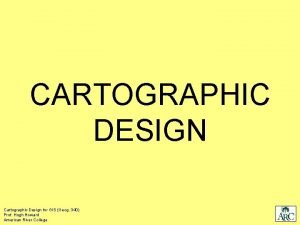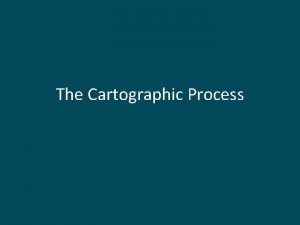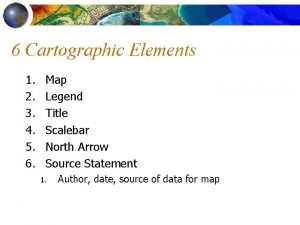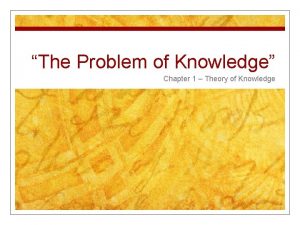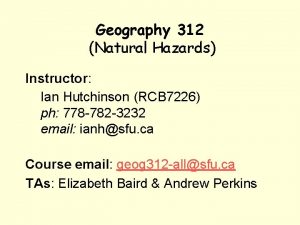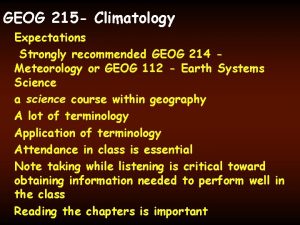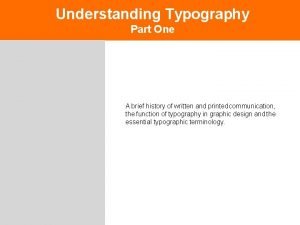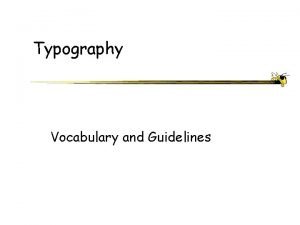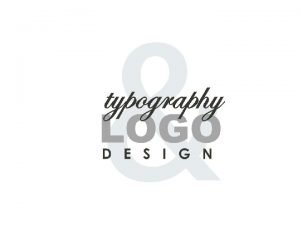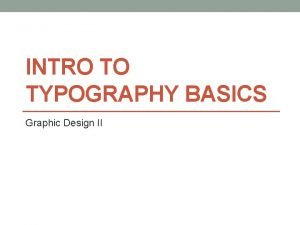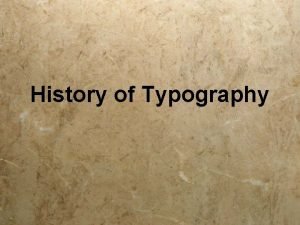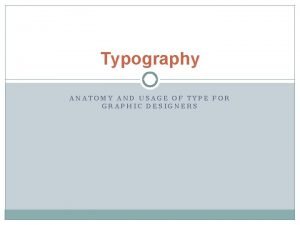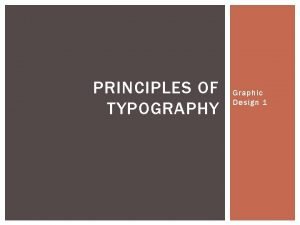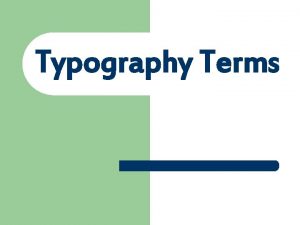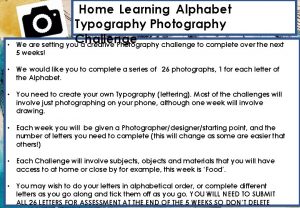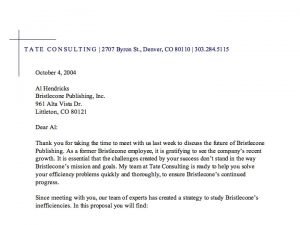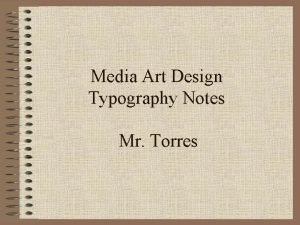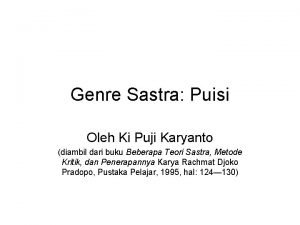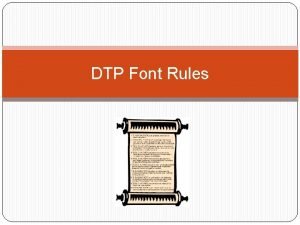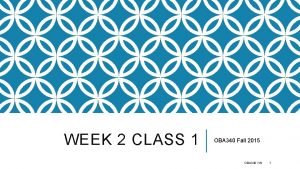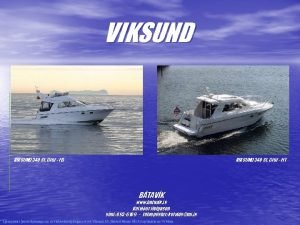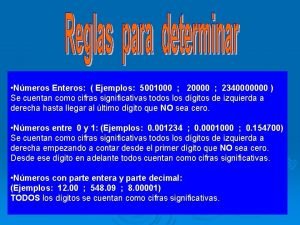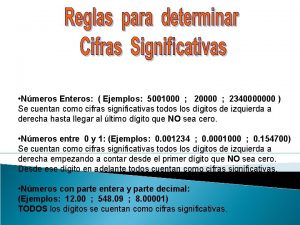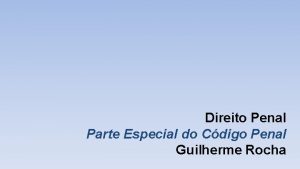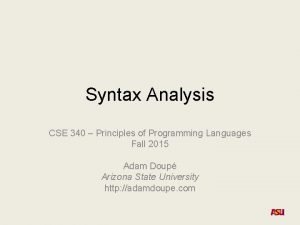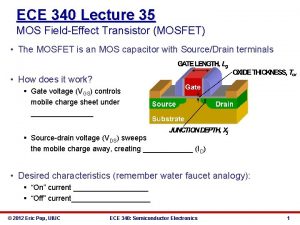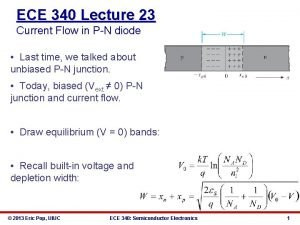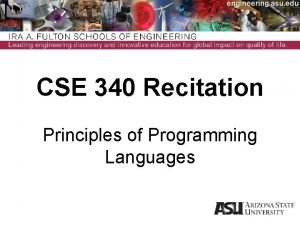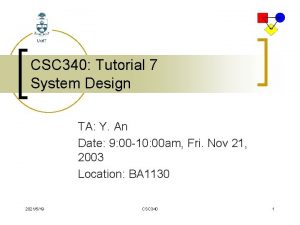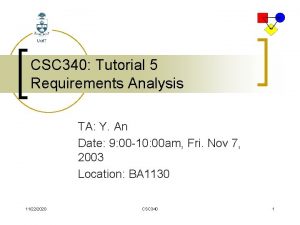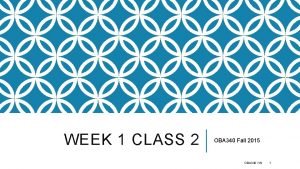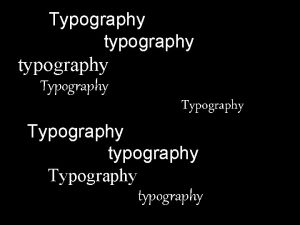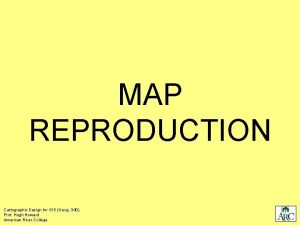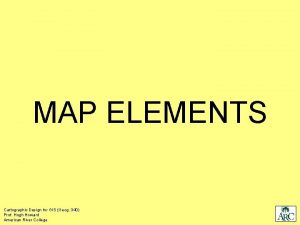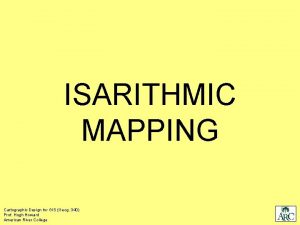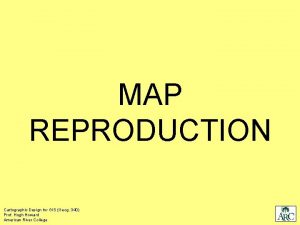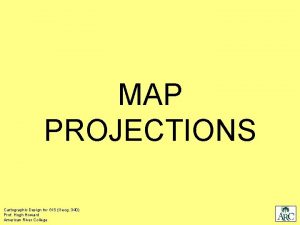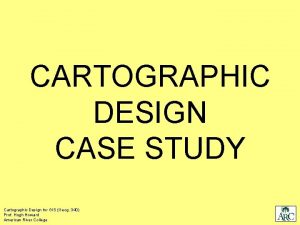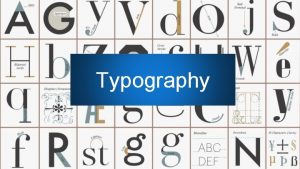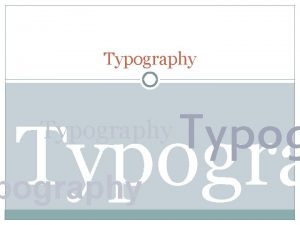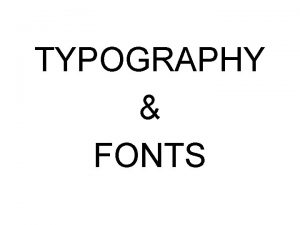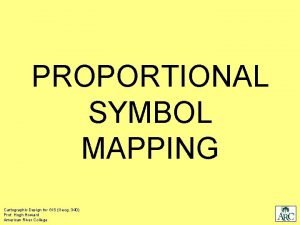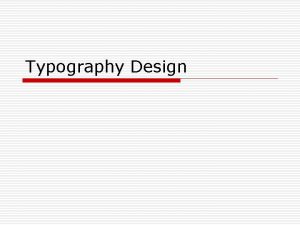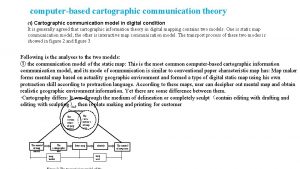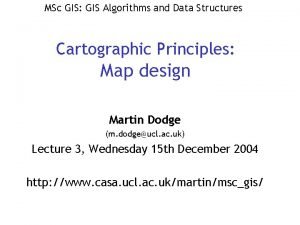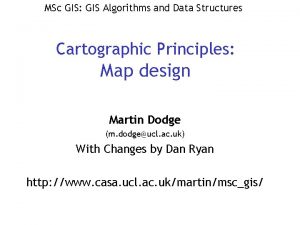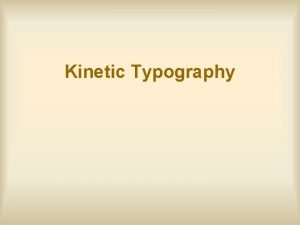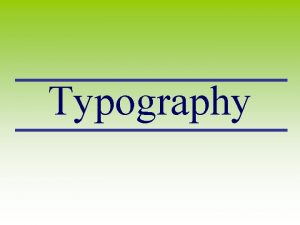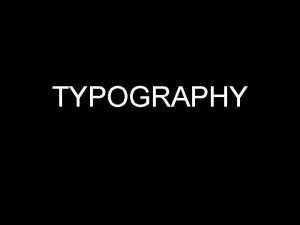TYPOGRAPHY Cartographic Design for GIS Geog 340 Prof













































- Slides: 45

TYPOGRAPHY Cartographic Design for GIS (Geog. 340) Prof. Hugh Howard American River College

INTRODUCTION to TYPOGRAPHY

TYPOGRAPHY • • • Type, or text, refers to the words that appear on maps Typography is the art or process of specifying, arranging, and designing type Well-designed type can make a map easier to understand more attractive

TYPOGRAPHY • Several map elements are composed partly of type, and others are composed entirely of type – Type can be considered a special symbol, or even a map element in its own right • Type plays in indispensable role in cartography – But is often taken for granted, or treated as an afterthought

TYPOGRAPHY • The integral role of type Graphics and Type

TYPOGRAPHY • The integral role of type Type Only

TYPOGRAPHY • The integral role of type (cont. ) Graphics Only

TYPOGRAPHY • The rules and guidelines for the use of type in cartography are derived from general rules of typography – But have been modified over time to reflect the specific purposes of mapmaking – Fortunately, these rules and guidelines are relatively well defined

TYPOGRAPHY • Build a foundation of typographic skills by following the specific rules and guidelines presented here – Consider alternative approaches once you master these rules and guidelines – Always be prepared to explain or defend your typographical decisions

CHARACTERISTICS of TYPE

CHARACTERISTICS • Type is commonly organized according to the following characteristics – – • Type Family Type Style Typeface Type Size Additional terms include – Font

CHARACTERISTICS

CHARACTERISTICS • A Font – Is a set of all alphanumeric and special characters of a particular type family, type style, and type size Helvetica Roman 14 point

CHARACTERISTICS • Uppercase and lowercase letters are used in cartography, but lowercase have proven to be easier to read – Lowercase letters are less blocky, and provide more detail that helps differentiate one letter from another

CHARACTERISTICS • The majority of type on a map should be set in Title Case – Title Case is appropriate for use in titles, subtitles, legend headings, legend definitions, labels for point and line features, and so on

CHARACTERISTICS • Sentence case is appropriate when formal sentences are used – Sentence case can be used for textual explanations or descriptions appearing on a map

CHARACTERISTICS • Words set in all UPPERCASE – Are appropriate as labels for areal features – Are sometimes used as short titles

CHARACTERISTICS • Serifs are short extensions at the ends of major letter strokes – Type families with serifs are termed serifed; type families without are sans serif (without serifs)

CHARACTERISTICS • Serifed type is preferred in the context of written documents – Neither has proven to be more effective on maps – Both are used in cartography • In certain situations, both can be used – A serifed family can be used for one category of features (e. g. , natural) – A sans serif family can be used for another category (e. g. , cultural)

CHARACTERISTICS

CHARACTERISTICS • • Letter Spacing (Character Spacing) is the space between letters in a word Word Spacing is the space between words

CHARACTERISTICS • Minimal letter and word spacing – Results in compact type that is often easier to place on complex maps • Slightly increased spacing – Results in type that appears to be less “cramped” and is easier to read – Employ slightly increased spacing

CHARACTERISTICS • Exaggerated letter and word spacing – Is often used in conjunction with alluppercase type when labeling areal features – The blocky nature of all-uppercase type normally requires greater letter and word spacing than lowercase type

CHARACTERISTICS • Letter and word spacing should be kept consistent – Within individual blocks of type – Among labels that are otherwise similar Inappropriate Appropriate

CHARACTERISTICS • Kerning refers to the variation of space between two adjacent letters – Different combinations of adjacent letters require different amounts of kerning to be visually consistent

CHARACTERISTICS • Leading, or line spacing, refers to the vertical space between lines of type according to their baselines – Leading should be great enough to allow multiple lines of type to be read easily, without wasted space between lines

GENERAL TYPOGRAPHIC GUIDELINES

GENERAL GUIDELINES • Avoid the use of decorative type families, and use bold styles sparingly – Script, cursive, and otherwise fancy styles are unnecessarily difficult to read – The overuse of bold can overshadow other type and map elements; it is often unnecessary with appropriately sized type Bold and Decorative Type

GENERAL GUIDELINES • If possible, italic type should be reserved for specific applications – To label hydrographic (water) features Italics are appropriate for hydrographic features because their slanted form resembles the flow of water

GENERAL GUIDELINES • If possible, italic type should be reserved for specific applications – To identify publications in the data source (publications only!) The use of italics for publications is standard bibliographic practice

GENERAL GUIDELINES • If possible, italic type should be reserved for specific applications – To identify the species of an organism By convention, the first word (genus) is capitalized

GENERAL GUIDELINES • Avoid using more than two type families on a given map – Simpler maps can be limited to one – For consistency, all map elements should employ the same type family – If two type families are required, choose families that are distinctly different—one serifed and one sans serif, for example

GENERAL GUIDELINES Natural vs. Cultural Thematic Symbols vs. Base Information

GENERAL GUIDELINES • Choose a realistic lower limit for size – All type needs to be readable by the intended audience – Factors include the map user’s age, proximity to the map, map reproduction method, anticipated lighting conditions… – If possible, provide a sample to members of the intended audience

GENERAL GUIDELINES • Type size should correspond with the relative sizes of features – For example, type representing large cities should be noticeably larger than type representing small cities

GENERAL GUIDELINES • Type size should correspond with the relative importance of map elements – Type associated with more important map elements should be larger Avoid size differences of less than two points if possible

GENERAL GUIDELINES • Orient type horizontally – Except when labeling diagonal or curved features, in which case the type should reflect the orientation of the features

GENERAL GUIDELINES • Avoid overprinting and, when necessary, minimize its effects – Overprinting occurs when type is placed on top of a map feature, obscuring the type and making it difficult to read

GENERAL GUIDELINES • The effects of overprinting can be minimized through the use of – Masks – Halos – Callouts

GENERAL GUIDELINES • A mask is a polygon placed below type, but above the mapped area – Masks can sometimes obscure too much of the mapped area – Masks can be specified with the same color as the underlying area

GENERAL GUIDELINES • A halo is an extended outline of letters – Haloes cover less of the underlying mapped area than masks, while still allowing the type to be read – Don’t make haloes so thick that they attract undue attention

GENERAL GUIDELINES • Callouts are a combination of mask and leader line – Callouts are effective, but should be used with caution – They are visually dominant and can overshadow other map elements

GENERAL GUIDELINES • Critically evaluate and apply type specifications – Do not passively accept the default settings provided by software applications – Instead, consider the purpose of each unit of type in the context of the map, and apply type specifications accordingly

GENERAL GUIDELINES • All type should be spell-checked – Spelling errors interfere with cartographic communication, and undermine the credibility of a map • Beware of older place names – Many are considered to be offensive or derogatory by today’s standards

TYPOGRAPHY Cartographic Design for GIS (Geog. 340) Prof. Hugh Howard American River College
 Qualitative typographic visual variables
Qualitative typographic visual variables Typography design
Typography design Cartographic process
Cartographic process Cartographic elements
Cartographic elements Cartographic paradox
Cartographic paradox Unit 1 geog. of ga/ga’s beginnings
Unit 1 geog. of ga/ga’s beginnings May subd geog
May subd geog Geog 312 sfu
Geog 312 sfu Geography dse
Geography dse Geog 214
Geog 214 Geog
Geog Legibility
Legibility Typography vocabulary
Typography vocabulary Logo
Logo Intro to typography
Intro to typography History of typography
History of typography Anatomy of a font
Anatomy of a font Principles of typography
Principles of typography Eye typography
Eye typography A complete set of letterforms is known as a font or a
A complete set of letterforms is known as a font or a Typography minggu
Typography minggu Photography alphabet challenge
Photography alphabet challenge Typography concepts
Typography concepts Aplikasi typography
Aplikasi typography Typography rules
Typography rules Typography notes
Typography notes Tipografi anak tangga
Tipografi anak tangga Typography rules
Typography rules Typography notes
Typography notes Contoh typography
Contoh typography Oba-340
Oba-340 Viksund 340 santa cruz
Viksund 340 santa cruz 2,340,000,000
2,340,000,000 2,340,000,000
2,340,000,000 Mgt340 group assignment
Mgt340 group assignment 38 mos
38 mos Artigo 330 cp
Artigo 330 cp Szkoła podstawowa nr 340 warszawa
Szkoła podstawowa nr 340 warszawa Asu cse 340
Asu cse 340 Adam doupe cse 340
Adam doupe cse 340 Ece 340
Ece 340 Qualitative description of current flow at a junction
Qualitative description of current flow at a junction Cse 340 asu
Cse 340 asu System design tutorial
System design tutorial Csc 340
Csc 340 Oba-340
Oba-340
